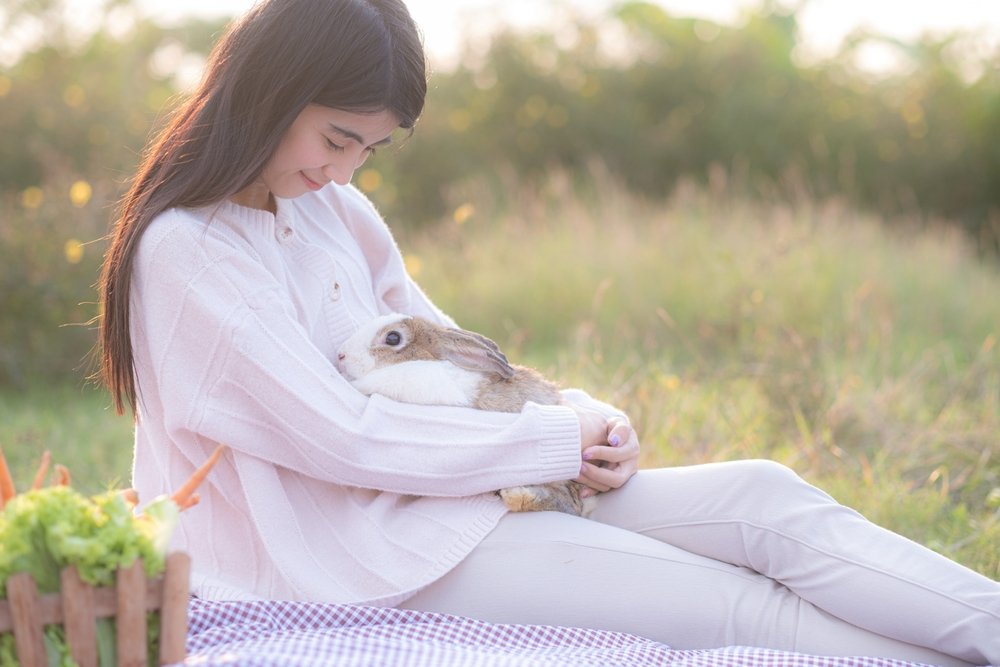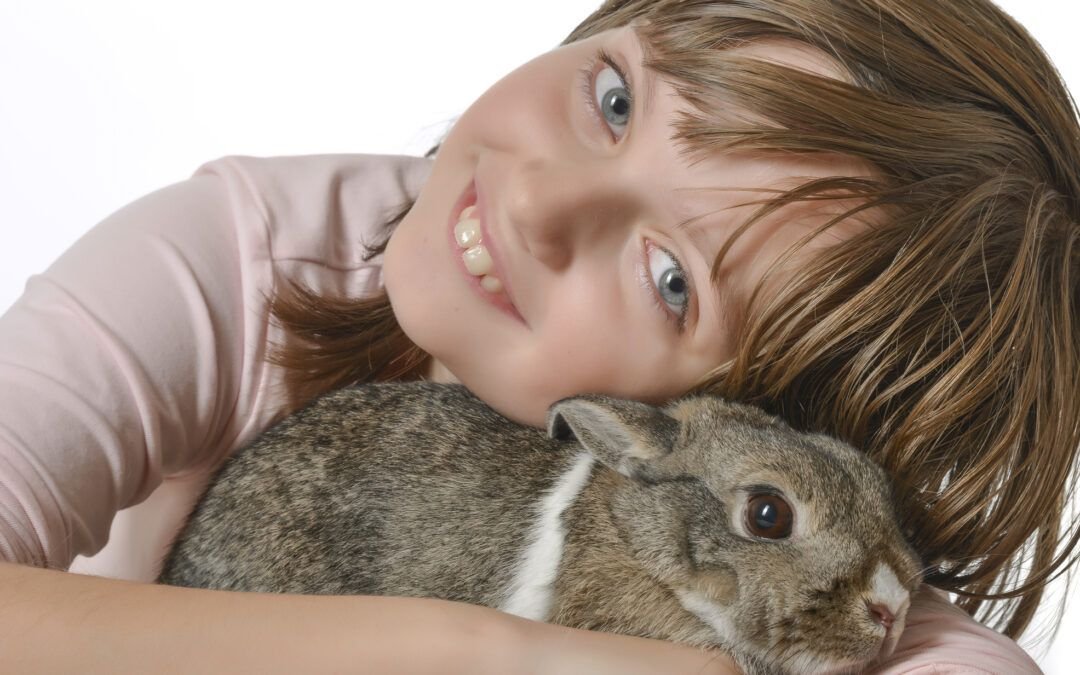Is rabbit as therapy animal beneficial? Absolutely! Rabbits are known for their gentle and docile nature. Besides, their cuteness brings a smile even to those with heavy hearts. This blog post will teach you the benefits of a therapy rabbit. You will also learn how to make an appointment with a therapy bunny and how to train therapy rabbit. Are you ready to learn more? Let’s proceed!

Rabbit as Therapy Pet
Household pets don’t only offer companionship but also assistance to their owners. According to the American Veterinary Medical Association, pets can help in three ways. These are services, emotional support, and therapy. Dogs are at the top of the list. But rabbit as therapy pet is recognized by many nowadays.
But what does a therapy rabbit do?
A therapy bunny differs from a service pet or an emotional support pet. It is trained to give affection and comfort to people in stressful situations. This pet is usually seen in disaster areas, nursing homes, hospitals, and schools. Furthermore, there are three classifications a therapeutic animal may belong to. These are animal-assisted therapy, therapeutic visitation, or facility therapy. To give you an idea, here is a table showing the differences in the classifications:
|
Therapy Animals |
Assistance Animals |
||
|
Main goal is to be beneficial to many people |
✔ |
X |
X |
|
Provide support to one person |
X |
✔ |
✔ |
|
Have permission to approach public areas |
✔ |
X |
X |
|
Tolerance to new areas has been evaluated |
✔ |
X |
✔ |
|
Permitted to live in housings even those with “No Pet” policy |
X |
✔ |
✔ |
|
Have special rights to access public establishments |
X |
X |
✔ |
|
Permitted to fly in the airplane’s cabin |
X |
✔ |
✔ |
When quiet therapy is needed, a rabbit is an effective therapy pet. It is also ideal for those who are afraid of cats and dogs. Moreover, it is easier to transport compared to other pets. You can also efficiently train therapy rabbit, similar to a cat or a dog. However, you must ensure that it is calm and well-socialized to be an effective therapy pet.
Rabbit as Therapy Pet: Who Can it Help?
In a study, elementary students showed high levels of anxiety. It affected their interactions with their teachers. But after their interaction with dwarf rabbits, students’ anxiety declined. Hence, it was concluded that a rabbit as therapy pet is effective in helping anxious students. Besides students, a therapy rabbit can comfort those experiencing mental health conditions. Some of these are trauma, depression, schizophrenia, and substance use. Adolescents with autism and emotional problems can enjoy interacting with a therapy bunny.
Plus, bunnies can help people with disabilities like stroke and multiple sclerosis. Most of them had successful animal-assisted therapy after observing and interacting with rabbits. Those who have problems with dexterity can find it beneficial to give treats to the rabbit or pick up its toy.
Moreover, playing with your pet rabbit can provide exercise if you have weakness issues. Those who need speech therapy find it helpful when they read out loud to a bunny or when they try to call its name. Because of its gentle personality, a rabbit can help people experiencing stressful situations. Watch the video below on how a therapy rabbit helps with the recovery of a patient.
Benefits of Rabbit as Therapy Pet
Interacting with rabbit as therapy pet have lots of benefits for health. It can increase your self-esteem and provides social development. Plus, it improves social skills and develops nurturing skills and empathy. You can also experience improvement in your mobility, strength, and flexibility.
Most people who have interacted with rabbits have lower levels of depression. Aside from that, they also improve their relationships with the people around them. A therapy rabbit also provides a better quality of life and reduces stress.
In addition, interacting with rabbits bring laughter, releasing endorphins in the brain. They are the hormones responsible for reducing stress, relieving pain, and improving well-being. According to scientists, cuddling pets also helps release oxytocin. It is also known as the “love hormone” or “cuddle hormone”. This hormone reduces cortisol levels and lowers blood pressure.
Also, bunnies are more convenient!
Because of its size, a therapy bunny is easier to handle than a dog or cat. Hence, it is suitable for disabled or weak people who have difficulty carrying heavy pets. A bunny is also more convenient to transport to different hospitals and schools. You will also find it easier to bring it on air travel.
As quiet pets, rabbits are ideal for those undergoing “silent therapy”. It is the kind of therapy wherein the client retreats and shuts off from noisy environments. Bunnies rarely make noises. And when they do, it does not create stress. You will feel relief and joy by simply looking at them, hopping, and playing.

Things to Consider Before Having Rabbit as Therapy Pet
Although a rabbit as therapy is beneficial, there are things to consider. If you fear animals, interacting with them is not a good idea. Others may also have a fear of bunnies called leporiphobia. People with this phobia may experience crippling anxiety when encountering these furry pets. However, this case is uncommon.
Unfortunately, it would be better to have a therapy rabbit if you are allergic to it. People should prevent bunnies since they may experience rashes, bronchitis, or asthma. There are other options besides a therapy bunny. Dogs, cats, and guinea pigs are some of them. Clients who have weak immunity are discouraged from interacting with a therapy pet. It is because interaction with animals may only worsen their condition. But if you want to, you can consult your doctor regarding your situation.
Qualifications of Rabbit as Therapy Animal
If you are interested to train therapy rabbit, know the qualifications. The criteria may differ depending on the organization. However, your pet must qualify for the standard criteria.
First, your bunny must have trimmed nails. One of the goals of the AAT is to provide a safe interaction with rabbit as therapy animal. Bunnies with long nails may scratch the clients, leading to a stressful encounter. You must keep your pet’s nails trimmed every six to eight weeks.
Next, you have to ensure that your pet is healthy overall. Rabbits with poor health are more prone to spread parasites like mites. As a therapy rabbit, your pet must bring comfort and not an illness to the clients. It may also socialize with people who have a low immunity system. Thus, your bunny must be healthy.
Another qualification that you must remember is the demeanor of your bunny. A therapy bunny must show calmness when interacting with other people. It must also love to be cuddled and petted. You can observe how your pet reacts when interacting with strangers. A stressed bunny tends to hide, pull away, and become tense.
Moreover, you must train therapy rabbit to wear a leash and a harness. When visiting clients, rabbits need to wear a four feet leash. It must also be comfortable to travel in a car or a plane. As much as possible, your pet must be calm in new places, even those with loud noises. It would also be better to train your bunny how to use its litter box.

Registering your Rabbit as Therapy Animal
If your bunny meets all requirements for a rabbit as a therapy animal, register it. There are different organizations where you can register your bunny. However, most animal handlers in AAT prefer registering their pet in Pet Partners. It is an organization that promotes the benefits of AAT.
To register your pet as a therapy rabbit, you must first create an account on their webpage. You have to provide your and your bunny’s basic information. Once done, they will give you access to a calendar where you can register for an evaluation or a workshop. By using your account, you will also be able to explore other tools and resources.
Next, you have to take the handler course. Remember, it is a course for you, not your pet. The organization will teach you how to be responsible. You will also know what to expect to have a successful visitation. You can take the course personally, or you can also take it online.
For the next step, you have to fill in the screening form that the organization will provide. It should be signed by the vet, confirming that your pet is healthy enough to be a therapy bunny. After that, you have to attend the team evaluation. It is where you have to prove that you can make effective visits. An evaluator will provide you with a simulated animal therapy visit.
Lastly, you must accept the volunteer agreement. Next, upload your and your pet’s photo since it will be used for the ID badge. Finish the Background Check that will be sent to you through email. Wait for the registration confirmation letter from the organization before you begin visiting.
Training Rabbit as Therapy Pet
Litter training
First and foremost, you must train therapy rabbit how to use its litter box. It is one of the essential qualifications to accept a rabbit as therapy animal. As much as possible, your pet should not pee on the client’s house during visitations. If your rabbit does not know how to use its litter box, you must teach it.
To begin, you must pick a suitable litter box for your bunny. Place it on the spot where your rabbit pees a lot. Putting its droppings inside the litter box will also help it recognize its use. You must give treats to your bunny whenever it uses its litter box. If your pet is an indoor rabbit, you can put more boxes in some areas of your home.
Leash Training
As a therapy rabbit, your pet must get used to wearing leashes. It is crucial when you have to visit hospitals and schools. First, help your bunny get familiar with the leash by putting it beside your bunny. Once it get used to it, you can let your pet wear the leash. Have a short walk with your bunny while it is wearing the leash. As it gets more comfortable, you can have long walks.
Sitting on baskets
Sitting on baskets is one of the tricks performed by most therapy rabbits. Hence, your therapy bunny must know how to do the trick. First, place the basket near your pet. Using a target stick, guide your pet into the basket. Give your bunny a treat if it goes inside the basket. Now, teach your bunny to stay in the basket while lifting it.

Best Breeds of Rabbit as Therapy Pet
Mini Lop
If you want to train therapy rabbit, a Mini Lop is a good choice. Known as the Monarch of the Fancy, Mini Lops are famous for their cheerful and friendly demeanor. Hence, they quickly get along with kids. This breed is also intelligent, so it is easy to learn new tricks. With enough training, it can recognize its name and respond to verbal commands.
Mini Rex
Because of its calmness, you can train a Mini Rex rabbit as therapy animal. You won’t also have difficulty bringing it to new places since it is a breed that loves to explore the outdoors. It is also sociable, even to strangers. Moreover, this bunny loves to spend time with kids because of its playfulness.
Holland Lop
Besides being cuddly and adorable, a Holland Lop is also known to be calm and friendly. Hence it can be a good therapy rabbit. Children also love these bunnies because they are easy to handle. It is also one of the breeds which hop to its owner’s lap to ask for some cuddling and petting.
Flemish Giant
Despite its giant size, many clients love interacting with a Flemish Giant. It is because this bunny craves attention and affection. Because of intelligence and curiosity, a Flemish Giant is almost similar to a gentle dog. In fact, this bunny has its way of greeting its owner.
Dutch
Due to its friendly behavior, a Dutch rabbit is a good therapy rabbit. It loves to play outdoors, making it easier to handle during visits. But ensure that the bunny is handled correctly when interacting with small children. Since this rabbit is medium in size, kids at young ages may have difficulty carrying it.

Frequently Asked Questions
Is interacting with a therapy bunny relieving stress and anxiety?
Absolutely! Because of its docile and friendly personality, a therapy bunny can reduce anxiety. It also develops decreases stress caused by traumatic emotions. Other benefits are the development of social skills and the improvement of well-being.
Is it easy to train therapy rabbit?
It depends. Some breeds are easier to train than other bunnies. But through your time and commitment, you can train therapy rabbit. You must teach it basic tricks such as using its litter box, walking with a leash, and sitting inside a basket.
Should I register my rabbit as therapy animal?
If your pet meets the requirements, you can register your rabbit as a therapy animal. There are organizations where you can register your bunny. You must have certification to visit your pet without conflict or confrontation.
Can a therapy rabbit help people with health conditions?
Interacting with a therapy rabbit can develop mobility, flexibility, and strength. Activities like picking up the bunny’s toys and giving it treats can be forms of simple exercises. Playing with the bunny can be beneficial to you physically and emotionally.
What are the requirements to be a therapy bunny?
Some requirements to be a therapy bunny include good health, trimmed nails, and clean fur. Your pet must also be calm when interacting with others, especially strangers. Plus, it must be able to transport in a car or via plane without experiencing stress. It is also vital that your bunny knows how to use its litter box and walk wearing a leash.

Conclusion
Having a rabbit as therapy animal has lots of benefits, emotionally and physically. This furry pet can reduce your anxiety, especially if you are in a stressful situation. Besides, playing and interacting with it can improve mobility, flexibility, and strength. Rabbits also bring laughter that helps release good hormones in your body.



